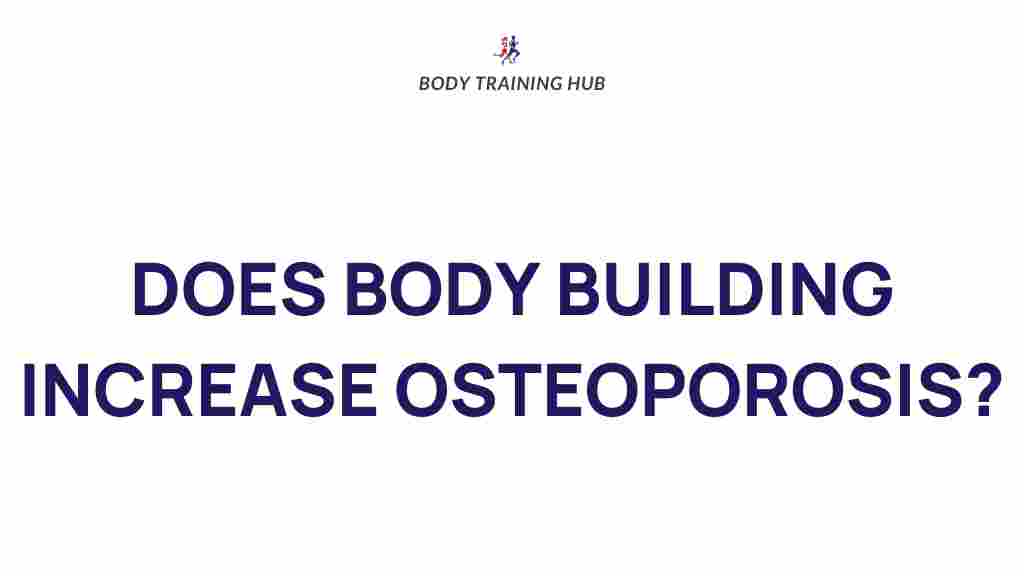Unveiling the Surprising Link Between Bodybuilding and Osteoporosis
When most people think about bodybuilding, they envision bulging muscles, intense workouts, and a strict diet. However, an often-overlooked aspect of bodybuilding is its profound impact on bone health, particularly in relation to osteoporosis. Osteoporosis is a condition characterized by weakened bones and decreased bone density, making individuals more susceptible to fractures. As the population ages, the relationship between strength training and osteoporosis becomes increasingly significant. In this article, we will explore how bodybuilding and weightlifting can improve bone density and overall bone health.
The Importance of Bone Density
Bone density refers to the amount of mineral matter per square centimeter of bones. Higher bone density usually translates to stronger bones, which can better withstand the stresses of daily activities and exercise. Key factors influencing bone density include:
- Genetics: Family history can play a significant role in bone health.
- Nutrition: Adequate intake of calcium and vitamin D is crucial for bone strength.
- Physical Activity: Weight-bearing exercises like bodybuilding promote bone growth.
- Age: Bone density generally decreases with age.
Understanding these factors is essential for anyone looking to enhance their bone health, especially those at risk of osteoporosis.
How Bodybuilding Contributes to Bone Health
Bodybuilding and strength training are not just about building muscle mass; they also play a pivotal role in maintaining and improving bone density. Here’s how weightlifting can influence bone health:
- Mechanical Loading: Lifting weights creates mechanical stress on bones, stimulating bone remodeling and growth.
- Increased Muscle Mass: More muscle mass means greater force applied to bones, enhancing their strength.
- Hormonal Benefits: Strength training promotes the release of hormones like testosterone and growth hormone, which are vital for bone health.
- Improved Balance and Coordination: Regular weightlifting improves balance, reducing the risk of falls that can lead to fractures.
These benefits illustrate the importance of incorporating bodybuilding into a fitness routine, especially for those concerned about osteoporosis.
The Science Behind Strength Training and Bone Density
Research has consistently shown that strength training can lead to significant increases in bone density. A study published in the Journal of Bone and Mineral Research found that individuals who engaged in regular weightlifting experienced a notable increase in their lumbar spine and hip bone density. This is critical since hip fractures are a common consequence of osteoporosis.
Moreover, strength training is particularly beneficial for postmenopausal women, who are at a higher risk for osteoporosis due to decreased estrogen levels. Engaging in a consistent bodybuilding routine can counteract some of the bone loss associated with menopause.
Creating an Effective Bodybuilding Routine for Bone Health
To maximize the benefits of bodybuilding for bone density, it’s important to follow a structured strength training program. Here’s a step-by-step guide:
Step 1: Consult a Professional
Before starting any new exercise program, especially if you have existing health concerns or osteoporosis, consult a healthcare provider or a certified fitness trainer. They can help tailor a program to your individual needs.
Step 2: Start with Weight-Bearing Exercises
Include exercises that promote muscle strength and bone health, such as:
- Squats
- Deadlifts
- Bench presses
- Overhead presses
- Leg presses
Step 3: Focus on Progressive Overload
To stimulate bone growth, gradually increase the weights you lift over time. This principle of progressive overload is key to challenging your muscles and bones.
Step 4: Incorporate Variety
Incorporate a range of exercises targeting different muscle groups. This not only prevents boredom but also ensures balanced muscle development and bone health.
Step 5: Prioritize Nutrition
Ensure you are consuming adequate amounts of calcium and vitamin D to support bone health. Consider adding these foods to your diet:
- Dairy products (milk, cheese, yogurt)
- Leafy green vegetables (kale, spinach)
- Fatty fish (salmon, mackerel)
- Nuts and seeds (almonds, chia seeds)
Step 6: Stay Consistent
Consistency is crucial for long-term benefits. Aim to engage in strength training exercises at least 2-3 times a week.
Troubleshooting Common Challenges
While bodybuilding can be beneficial for bone health, there can be obstacles along the way. Here are some common challenges and solutions:
- Challenge: Fear of injury.
- Solution: Start with lighter weights and focus on proper form. Consider working with a trainer.
- Challenge: Lack of motivation.
- Solution: Set specific, achievable goals and track your progress. Join a fitness group for support.
- Challenge: Time constraints.
- Solution: Short, high-intensity workouts can be effective. Plan workouts in advance to fit your schedule.
Conclusion
Bodybuilding is often associated with aesthetics and strength, but its relationship with osteoporosis and bone health is equally important. Engaging in regular strength training can significantly enhance bone density, reduce the risk of fractures, and promote overall fitness. By incorporating a well-structured bodybuilding routine, focusing on nutrition, and addressing common challenges, individuals can take proactive steps towards maintaining strong bones.
Whether you are a seasoned bodybuilder or a beginner, understanding the benefits of weightlifting on bone health is vital. Don’t underestimate the power of strength training—it could be the key to a healthier, more resilient future.
For more information on fitness and bone health, check out this resource. Remember, investing in your fitness today is an investment in your bone health for tomorrow!
This article is in the category Strength & Recovery and created by BodyTraining Team
